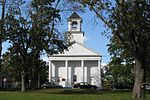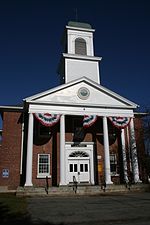Thomas Lumb Three-Decker (Dewey Street)
Apartment buildings in Worcester, MassachusettsApartment buildings on the National Register of Historic Places in MassachusettsHouses completed in 1894National Register of Historic Places in Worcester, MassachusettsQueen Anne architecture in Massachusetts ... and 2 more
Triple-decker apartment housesWorcester, Massachusetts Registered Historic Place stubs

The Thomas Lumb Three-Decker is a historic triple decker house in Worcester, Massachusetts. It is a well-preserved example of the style in Worcester's Piedmont section with Queen Anne styling. The building follows the typical side hall plan, and features porches on the front with turned posts and spindle friezes. Other details, including decorative brackets in the extended roof overhang and elements of the window surrounds, have been lost since the property was listed on the National Register of Historic Places in 1990.
Excerpt from the Wikipedia article Thomas Lumb Three-Decker (Dewey Street) (License: CC BY-SA 3.0, Authors, Images).Thomas Lumb Three-Decker (Dewey Street)
Sylvester Street,
Geographical coordinates (GPS) Address Nearby Places Show on map
Geographical coordinates (GPS)
| Latitude | Longitude |
|---|---|
| N 42.258333333333 ° | E -71.881666666667 ° |
Address
Sylvester Street
Sylvester Street
01611
Massachusetts, United States
Open on Google Maps









